What is a facilitator and what do they do?
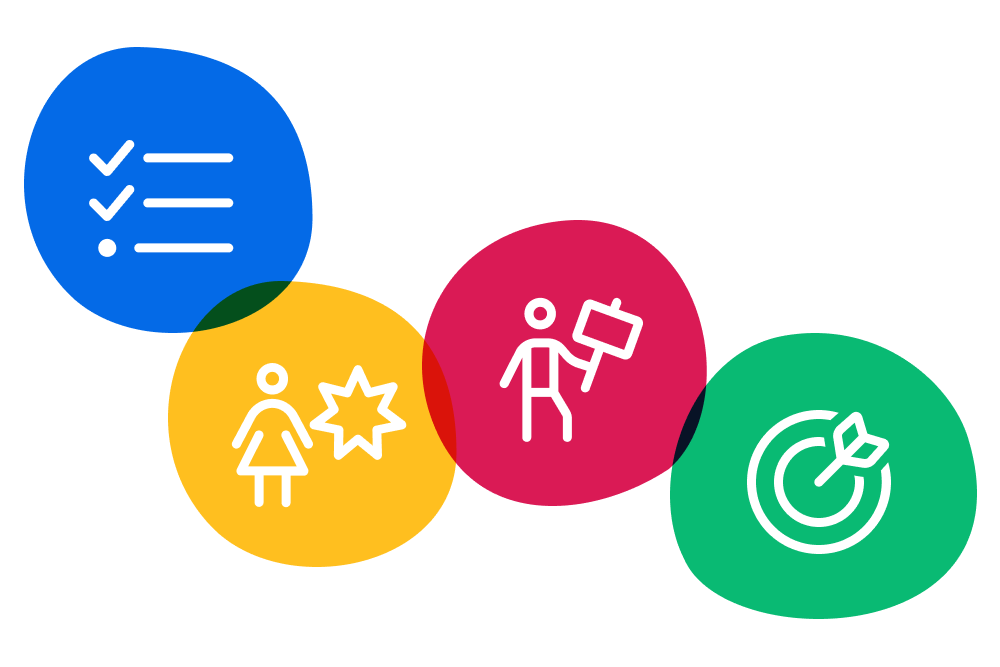
As a professional facilitator, there are certain questions I find it really hard to answer. Such basic, chit-chat-at-the-dinner-party questions, in fact, that it’s almost embarrassing. Questions like: What is a "facilitator"? Why do people hire you? What is it that you actually do?
To get to the bottom of these matters I’ll be using my own experience, that of colleagues from my networks and, in particular, data drawn from the State of Facilitation in 2023 report, which is based on over 1100 responses to a global survey.
If you are considering starting a career as a facilitator, read on to be prepared for all these questions that will soon be coming your way.
If you are here because you might be hiring facilitators yourself, I hope you’ll find some good insights into what to look for. Finally, if you are a colleague, I’d love to hear your feedback on this piece. Do my answers match your experience? What did I miss?
In this article, we will look at:
What is a facilitator?
Asking ChatGPT will give you a pretty good answer. “A facilitator is a person who helps to guide and manage group discussions and activities in order to achieve specific goals or outcomes. They act as a neutral party who promotes open communication, fosters collaboration, and ensures that all participants are heard and their contributions are valued. A facilitator typically does not take an active role in the conversation or provide solutions, but instead serves as a guide to help the group members generate their own ideas and come to their own conclusions.”
The explanation of this role as given by the IAF, the International Association of Facilitators, is not that different, if perhaps more nuanced, as it stresses impartiality, and balance between the group and the individual. “Facilitators fill an impartial role in helping groups become more effective. They set aside their personal opinions and support a group in making its own choices. Facilitators act as process guides and create a balance between ensuring individual participation and producing meaningful results.”
Looking at what these (and other) definitions have in common, here are some key elements to highlight:
- Facilitators work 1-to-many rather than 1-to-1: although we will talk one-to-one for interviews with participants, or when negotiating with a client, most of our work is with a group of people. This is helpful, for example, to distinguish the role of facilitator from that of leadership coach;
- The facilitator’s role is to support a group’s process, steering it by, for example, designing activities, opening an important discussion and offering key questions. Content in a facilitation process comes from participants themselves (as opposed to what might happen with public speaking or training);
- A facilitator’s position is neutral with regards to the content (but not with regards to the process). It is part of the facilitator’s job to make sure different voices are heard in the room, but not to choose among those voices or suggest solutions (as opposed to more “traditional” consultancy roles). Facilitators have opinions, of course, but staying neutral and setting them aside to focus on allowing the group’s opinions to surface is important.
We can summarise the above by saying that a facilitator designs and runs group processes with the aim of making it easy for everyone to contribute and achieve a shared goal.
Facilitators often also have coaching, mediation or teaching/training skills; these are all different roles, different hats that can be worn by the same person.
As a tutor for students in a summer school program, for example, I am sometimes acting as a coach (in individual conversations with participants), sometimes as a trainer (providing short classes on communication skills), occasionally as a mediator (stepping in to offer support in a conflict) and mostly as a facilitator (designing a learning process and setting up activities to support individual participants to come together as an effective learning group).
What is the purpose of facilitation?
A facilitator’s attention goes to encouraging rebalancing the three pillars of group work: objectives, relationship, and process.
Objectives answer the question: what is the aim of our work together? What do we want to achieve? This is the realm of KPIs, targets, and concrete outputs. What does a successful future look like for the team? What is the groups’ desired outcome? What values would we like to embody on the way?
Process is about how we work together. What are our group processes? Who takes decisions? How do we keep one another accountable? How do we learn (from success as well as failure)? Here, an effective facilitator will help groups take control of their process, and may touch on elements of collaborative task management and collaboration and team problem solving.
Taking care of relationships is about raising mutual trust inside the group. Who are we working with? How well do we know one another and communicate? Helping people learn how to participate effectively and with mutual respect is a vital element of effective facilitation.
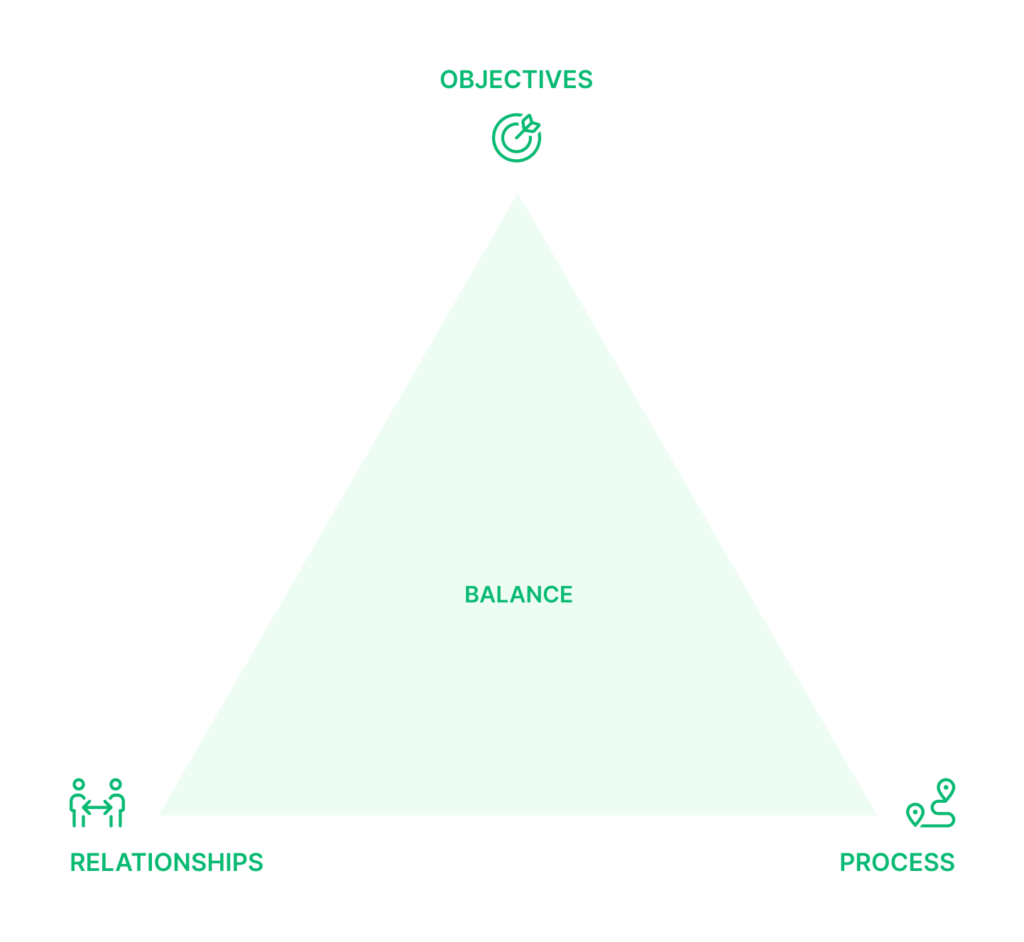
Depending on the needs of the specific team and job, a skilled facilitator will design activities that help the group reflect on its current situation and steer towards change in one, two, or all of these dimensions. Let’s see a couple of examples.
In business scenarios, facilitators often encounter teams that have dedicated their time almost exclusively to objectives, to the detriment of process and relationships. Trust might be eroded or there may be a lack of clarity on how to work together effectively. New conditions such as online work make it especially clear when process is badly defined: lots of energy and time can get wasted by duplicating efforts or leaving projects stalled in a bottleneck!
In such cases, an effective facilitator will suggest ways of working on the team’s cohesion, encouraging participation and setting agreements as to how to work together, co-creating processes that fit that particular context.
Facilitation is sometimes misconstrued as a tool for “feeling good”, but the actual aim of getting-to-know-you games and playful energizers is to create a good environment in order to get things done! A few hours dedicated to diagnosing how the team is managing its own internal dynamics and learning new skills, such as in this team Self-Management workshop, can radically improve group effectiveness.
In non-profit contexts, such as citizen groups, I’ve sometimes diagnosed the opposite illness: the group is so focused on feeling good and creating internal cohesion that it’s not really advancing towards its objectives, or has never set clear objectives at all!
A facilitated workshop might then be devoted to creating or refreshing a shared vision and mission for the group. An ideation workshop, such as the one detailed in this template, might be just the thing. Taking a look through our template collection will give you more ideas of what a facilitated event or workshop can achieve!
What do facilitators do in practice?
Facilitators are experts in group process and group management. Malia Josephine, founder of the start-up Facilitation Jobs, has put together a comprehensive list of over 30 job titles that refer to facilitation, from Organizational Development Specialist and training facilitator to Retreat Designer and more. Not to mention the more creative (and still accurate!) descriptions you can find on Linkedin such as “social enzyme” or “conversation bricoleur”.
The list makes it clear that, as Voltage Control’s Douglas Ferguson put it in his commentary to the State of Facilitation 2023 report, “Facilitation is Everywhere”. Facilitators are present in private and public sectors, in NGOs and big corporates, facilitating board meetings and outdoor team building. What are all these facilitators up to?
Depending on the context and needs, here are some actions facilitators might typically take.
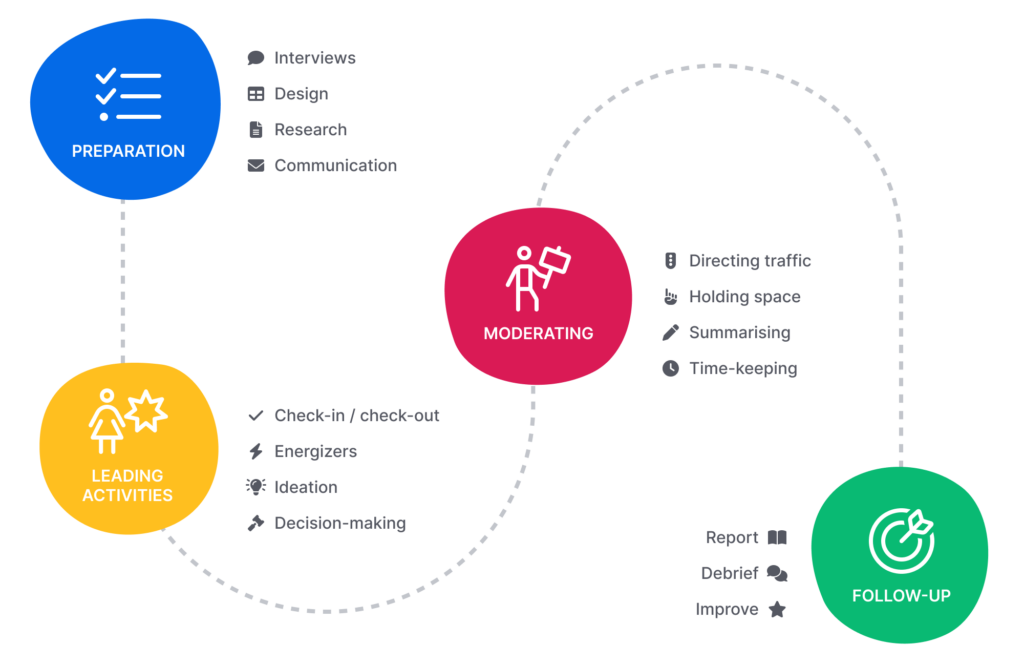
Facilitators will work behind the stage to design appropriate processes based on the task at hand. Some of a facilitator’s routine activities in this stage include:
Preparation & design
- interviewing key stakeholders, having meetings with the client (and other relevant roles such as, for example, someone in HR or in a communications role) aiming to understand current needs, past history and future hopes;
- designing meetings, events, workshops or retreats around the overall topic and purpose, including preparing lists of intended outcomes and a detailed agenda;
- reviewing, revising and amending that agenda with the client;
- suggesting needs for a location (such as how to organize seating spaces, how many tables are needed and so on) or, if the workshop is online, recommending what software to use;
- drafting information to include in the invitation and/or communicating directly with participants before the event to share expectations, inform them on what types of activities will be run, what technology will be used, considerations around accessibility and so on (for more about how to set up your facilitation events for accessibility, read Marie Dubost’s top tips)
- doing some research on the topic, e.g. by studying project documents, to get a grasp of the technical jargon or specialised knowledge participants will refer to.
Leading activities
An event agenda typically includes sections with speakers: parts of the day where information is presented by, for example the host/client, a department manager, the team presenting a challenge. Other points of the agenda will be participatory activities: here is where facilitators take the stage to introduce, give instructions, lead debrief sessions, clarify any questions. In such moments, facilitators will:
- Welcome participants, introduce the process;
- Propose activities that help co-create psychological safety, build a healthy group dynamic and set up a good environment for the day. These could be, for example, ice-breakers, energizers, creating ground rules, exploring personal motivations, and so on;
- Lead activities to encourage ideation, new ideas, creativity, brainstorming (divergence);
- Guide activities designed to reach a conclusion, such as consensus building, defining action plans, next steps, and finalizing outputs (convergence).
Moderating conversations
During conversations and discussions, facilitators use their moderation and meeting management skills to:
- Direct the traffic of conversation, for example using rounds, talking pieces, active listening, activities in pairs and small groups, setting time limits for people to speak, and so on. Facilitation does not necessarily mean “everyone will have exactly the same amount of time to speak in” (though sometimes it might) but it should mean everyone gets the opportunity to express their opinion, whether it’s in written form with sticky notes, in turns, or in a myriad other ways. Facilitators will encourage everyone’s participation (but should not enforce it! Some people prefer to be quiet and that is also ok);
- Step in to suggest ways of working through conflict. Not all facilitators have mediation skills, but expert professionals will have an understanding of how to handle conflict creatively and constructively;
- Summarise the conversation, ask clarifying questions, or suggest topics that push the group to go further in its thinking;
- Time management and taking meeting notes, or setting in place mechanisms to do that collaboratively (here is an example of how to do that).
Following up & debriefing
A facilitator’s work does not end when the meeting or event ends. Some typical tasks get done in follow-up, such as:
- Drafting reports. Often clients will request reports of how the project went. Make sure you have an agreement about what to highlight! I’ve had clients reveal to me only after an event was over that they needed specific data collected on participants, or surveys filled in. It would clearly have been much easier to collect such data points if we had had an agreement before!
- Sharing resources and materials. After a workshop it’s typical to send participants materials, resources, pictures, or reminders of any follow-up work to be done;
- Take part in debrief meetings and help collect learnings. A facilitator might in fact be the one insisting that the team meet again after the event or series of workshops to discuss learnings: what went well? What would we change next time? This is part of how we build a lasting, productive relationship with clients.
What do facilitators not do?
Here are 5 things facilitators typically should not be expected to do. Scouting locations, registering participants, setting up audio and video equipment are things facilitators might be able to do (I have found myself doing these myself upon occasion) but are not normally part of our role. If you are organizing an event or workshop, making sure you have a dedicated person to take care of logistics, enrollment and equipment will save you awkward misunderstandings. Most importantly, someone specialized in such tasks will surely do a better job of it!
The other two points on this list (providing content and offering solutions) are what really separates the facilitator’s role from the trainer, teacher, lecturer, or “traditional” business consultant. Bea Briggs from the International Institute for Facilitation and Change (IIFAC) has put together a handy table to distinguish the roles of facilitator, trainer, and speaker.
- A facilitator will not scout and book the location for you. Generally, the client takes care of finding the right location as well as of logistics such as catering or accommodation. That said, the setting of the room is a key element that influences the design of activities, as we shall see in more detail in the “What should I keep in mind when hiring a facilitator?” section below.
Often facilitators will know places they might recommend and/or have specific requests the client should keep into consideration. If the workshop is online, on the other hand, it is more likely that facilitators will suggest the software(s) they are most familiar with. - A facilitator’s job is not to enlist participants. I have occasionally been mistaken for a communication or a graphic design expert, which I’m certainly not! While some people might have skills in such areas, particularly those facilitators who organize their own workshops, preparing flyers and invites falls outside of a facilitator’s expertise.
Giving facilitators a say on what is written in the invite can certainly help set expectations, but the hosting team is more likely to do the actual work of creating visual assets and finalizing a participants’ list. - Facilitators should not be expected to set up the tech. While it is extremely common for facilitators to walk into the workshop space early in the morning and start rearranging tables and chairs, they should not be expected to set up audio-video equipment, microphones, cameras, and the like.
In online environments, facilitators are likely to be working with a dedicated “producer” or “tech host” to take care of all the backstage technical details. To learn more about the different roles that support facilitation, read our blog post on co-facilitation. - A facilitator is not a content expert. Hiring a facilitator who has expert knowledge of a certain topic may be a benefit, because it lowers the communication barrier if, for example, jargon and specialized terms are used. On the other hand, our “naive” questions can sometimes be a hidden gift, by creating a safe opportunity for participants to reveal that they do not fully understand something either.
Lately, this happened to me when facilitating a workshop on micromobility: during a pre-event briefing, I asked a question about what exactly the different categories of vehicles being discussed were. This led to discovering there were various interpretations of those categories and no clear consensus (yet). Result: my “stupid question” ended up becoming the first activity of a multi-stakeholder event, which in turn informed the first section of the resulting position paper (and possibly, a step toward clear consensus). - Lastly, of course, facilitators will not provide ready-made recipes to solve a team’s problems! One of the core tenets of facilitation is that the resources needed to create change and make steps forward lie within the team itself. If more resources are needed (such as, for example, an executive decision, more time, more funding) it’s still up to the team to find ways of moving towards its objectives. Facilitation can offer a safe space to design those pathways, and helpful tools to focus attention, but ultimately, results are determined by the participants!
Here is an article by Valerie Patrick listing other common misconceptions about facilitation, such as that it’s “just a gimmick” or “touchy-feely” or that it’s “a sign of weakness to let someone facilitate your meeting” (spoiler: it’s not).
What does a facilitation career look like?
Based on results of the State of Facilitation 2023 survey, 54.9% of facilitators are freelancers, working with multiple clients at a time, on many different projects. This is part of what I love about freelancing as a facilitator: as a perpetually curious person, this enables me to observe and partake in the efforts of many different teams on different fronts.
Not all facilitators work in this way though: another possibility is to be part of a team of facilitators in what effectively amounts to being small consultancy businesses. That’s the case of my friends Melania Bigi and Ilaria Magagna over at Tara facilitation: they’ve put together a group of facilitators, all with slightly different expertise (such as graphic facilitation, small-team leadership and development, decision-making, communication) with a focus on supporting small and medium enterprises.
Last but not least, there is the case of in-house facilitators. The rise of agile, design thinking, and design sprints has created a need for specialized roles available to offer facilitation services continuously and combine this with a deep understanding of the context. In-house facilitators mostly work in large companies, corporates, and foundations. They might be tasked, for example, with creating inter-departmental sessions for strategic planning, involving stakeholders in consultation processes, and designing customized trainings for staff.
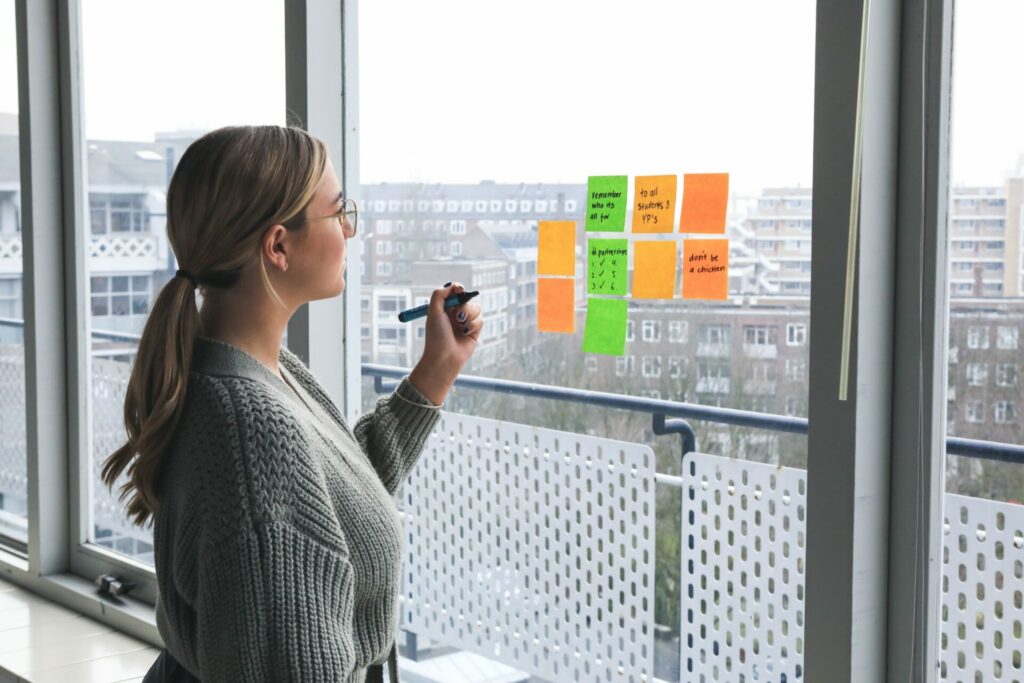
Whatever the position, facilitators’ daily life is likely to be divided into two main groups of tasks:
- Designing interventions. Whether it’s events, workshops, one-off or long-term, much of our time is spent at the desk and in preparatory meetings to define the objectives of our work, negotiate agreements with clients, interview stakeholders, design a learning process and set up agendas. I am going to include follow-up work here, despite the fact that it happens later, as it has a similar character of being backstage desk work. SessionLab’s Planner is a helpful tool at this stage, saving you time in designing, keeping all your sessions and methods neatly organized, and enabling you to share professional agendas with clients. To follow all the steps of how designing workshops works, here is an in-depth guide.
- Hosting/leading events, workshops, meetings. This is the most visible part of our work, when we are actually delivering to participants whatever design we’ve agreed on. This is when we step up, moderate conversations, interact, steer the flow of activities and so on.
The International Association of Facilitators, IAF, describes professional facilitators’ core competencies in this document. The list shows a balance between design and delivery: three Competency areas—Creating Collaborative Client Relationships, Plan Appropriate Group Processes, and Build and Maintain Professional Knowledge—revolve around preparation.
The other three are more focused on delivery: Create and Sustain a Participatory Environment, Guide Group to Appropriate and Useful Outcomes and Model Positive Professional Attitude. Reading through the details and the Code of Ethics will give you a very clear idea of what is important to know about professional facilitation.
When do you need a facilitator?
This is another version of the question “What do facilitators do”, this time slanted towards results and achievements. What impact does a facilitator’s work have? Where is the value?
Having a facilitator involved in a group process will improve the effectiveness of your work, saving you time, energy and, ultimately, money. The prime example of this is probably meetings: if your meetings leave everyone tired, confused and frustrated, a facilitator can help give them direction, organize the agenda, ensure the group stays on track to reach desired outcomes.
I have often had the opportunity of facilitating one or two-day kick-offs for large, multi-stakeholder projects: participants gathering from different Countries, using different jargons and working in different areas of expertise. By the end of the event, they should have clarity about their project, each individual team and person’s role in it, next steps, how communication will flow, timelines, and feel motivated about doing the project at all! A facilitator (or more likely in this case, a facilitation team) can help with all that.

If nobody is in charge of the process, there will be a lot of confusion, resulting in many more meetings and emails to be exchanged later. If the event is an unimaginative series of lecture-style presentations (I am quoting from a real-life situation here) people will say things like “the speeches took too long, and breaks were the only time when we could actually talk to one another and figure out how we will work together.”
Facilitation helps set up effective collaboration and maintains it in time. It also supports engagement and buy-in by ensuring everyone’s voice is heard early in the process. This can mitigate a lot of risks!
A colleague of mine recently facilitated public participation dialogues between a train company wanting to run a new line close to a mid-sized town and the local citizens. At the very first meeting, a group of citizens proposed a slight variation to the proposed track which would mitigate their concerns about car traffic changes: this was quickly accepted by the company.
One of the locals told the facilitator “If they had started building based on the original proposal we would have picketed the site for months! Thanks for saving us a lot of time and effort.” I also imagine it was a great return on investment for the train company, which had paid a few thousand Euros for the facilitation process.
Other facilitated activities such as using case studies or simulations help save time and money in the long run by “acting out” possibilities in safe environments, hearing out many different opinions, and different ways of thinking, before a decision is taken. For more on how facilitation helps decision-making, this article covers how to improve group decision-making and what common decision-making rules you might want to use.
Some of the most common reasons (and there are many more) I’ve witnessed for hiring a facilitator’s services include:
- the need to work with diverse stakeholders, such as the train company with local citizens;
- helping to align partners for a common aim, such as with EU-project kick-offs;
- supporting a new group to draft its vision, mission, aims, value statements and group agreements, as I do with new students in summer schools;
- boosting creativity and ideation, for example through design thinking workshops.
When should you hire a facilitator?
As we’ve seen so far, facilitation can help a group use its resources more effectively (and that includes time, money, and personal energy), by:
- making meetings more effective;
- improving interpersonal dynamics;
- mitigating risks;
- increasing buy-in and participation;
- managing conflict constructively.
It’s safe to say that ordinary, day-to-day meetings can be facilitated internally by the team itself (using tips and structures such as the ones you can find in this post on facilitating meetings).
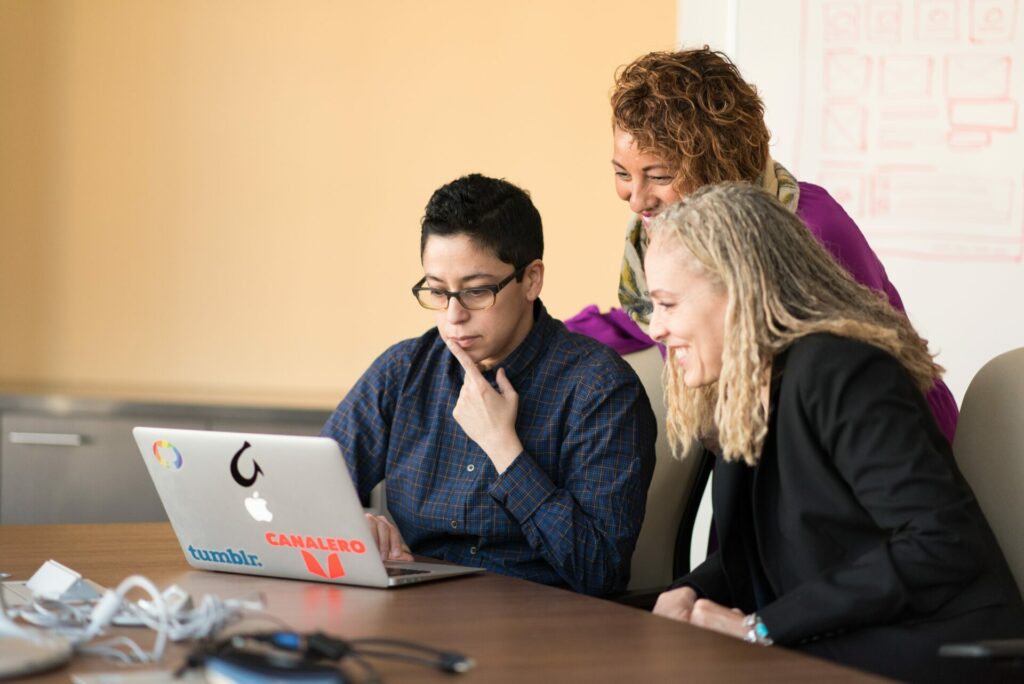
External facilitators should be called in if some of these conditions are met:
- a large or very large meeting, with over 20 participants (up to hundreds! Huge meetings are not an obstacle, as long as you have enough space, resources and people to cover different facilitation roles);
- diverse participants, in terms of origin, language, culture, background, expertise;
- the potential for conflict;
- situations of ambiguity and complexity where there is no “one given simple solution” to be found.
A great resource to answer the question of whether you need a facilitator or not is this checklist drawn from the 2013 book “Diverging Conversations Through Facilitation”.
What to keep in mind when hiring a facilitator
Once you have decided you do want to hire an external facilitator, here are four things you should keep in mind.
(1) Facilitators are specialists in process design. Draw them in early, before your agenda is set: that is how we can be most useful. I was recently hired for a one-day event in which the agenda had already been set to the minute, with lots of presentations and speeches, yet the hosts were “putting our faith in you to make it participatory.” I did my best, but interactions when you have to carve out five minutes here and there are inevitably limited!
(2) A good facilitator will help you define your requirements and desired outcomes, but the clearer your needs are from the beginning, the easier everyone’s job will be. Expect facilitators to ask you: when is the event (freelancers have crazy schedules), where is it (including online, in-person, or hybrid), who will attend, and what outcomes are you looking for?

If a facilitator recommends co-facilitating or investing in another role such as a graphic recorder to capture conversations, or a tech host online, don’t discount the suggestion offhandedly. Yes, it could cost you more, but there could also be real benefits to it. For more on co-facilitation and why it works, read here.
Facilitators have opinions regarding locations and those opinions have reasons! We are flexible and will work with anything (we have shared some fun stories in this community thread, including facilitating in a church and in a parking lot) but settings are important and have an influence on a workshop’s success.
The way lecture halls are typically built in Western Universities, for example, tell a story about where the power lies, who has the right to speak, and what is the best attitude for learning (seated, quietly taking notes). Workshop rooms designed to be flexible, with tables you can move about, space to hang up posters, chairs that can be arranged in many different ways tell a different story, about collaboration and creativity.
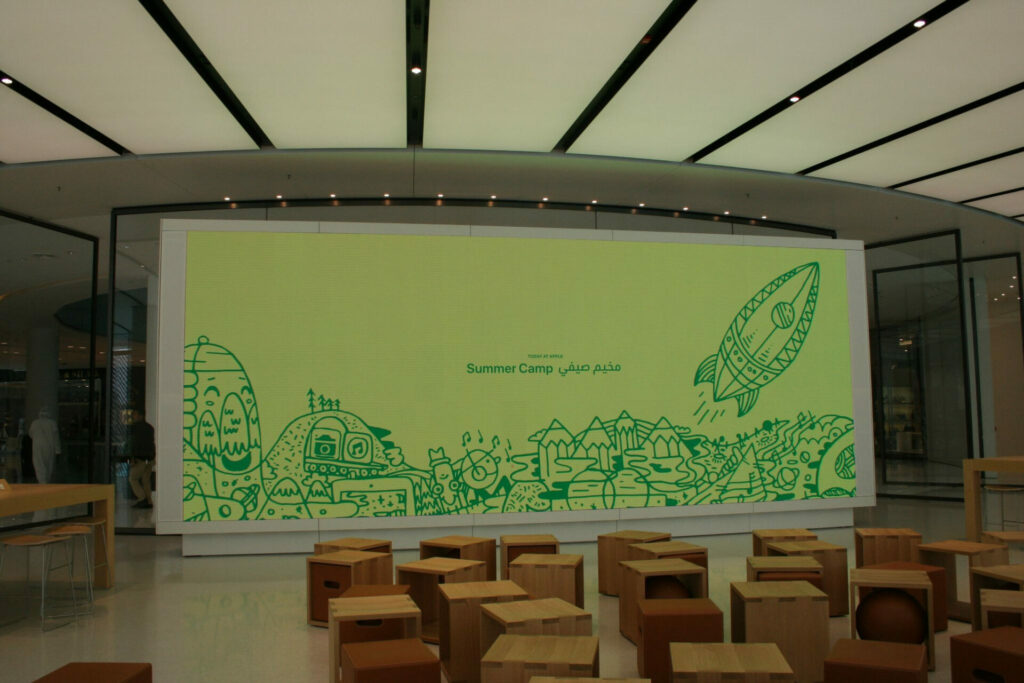
A facilitator might also have ideas around how to arrange a room in a way that is unexpected, and novel to participants. This is in itself a strong statement and sets the mood for the day: expect something unusual! With that in mind, it should come as no surprise if facilitators ask you to access rooms an hour (or more) before an event starts, if only to quickly rearrange the chairs!
How much does facilitation cost?
Given the variety of facilitation services out there, there is really no definitive way of answering this question. To get a general sense, you can check out the State of Facilitation report section on pricing for your geographical location and/or sector. A more detailed look at the topic, from a couple of years ago, comes from the NeverDoneBefore community’s pricing survey.
In both cases, the median price for a full-day workshop was given at about €3000. This is a good indication to start with, but as many respondents pointed out, there are many variables involved. Is the request to accompany a group in time, or a one-off event? How much preparation is required, how many meetings with staff? How large is the event? Are travel and accommodation covered?
If you are a facilitator working on how to price your services, I highly recommend this podcast episode on How to Price your Facilitation and Coaching services, hosted by Myriam Hadnes on Workshops Work, in which pricing expert Jenny Millar offers her reflections and top tips. After listening to it, I began to offer three-tier pricing options to potential clients, which is one of the tools recommended in the podcast.
I have found experimenting with this approach very helpful also because it forces me to articulate clearly what services I can offer extra (such as 1:1 interviews, or follow-up questionnaires), and should be paid extra for, versus what the bare minimum would cost. Negotiations on pricing, especially when a client is new and not familiar with facilitation yet, are also an opportunity to go deeper into explaining a facilitator’s role and value. Expect some back-and-forth negotiation!
Where are facilitation skills useful besides professional facilitation?
Requests for professional facilitation and facilitation skills are definitely on the rise. Changes in the workplace accelerated by the Covid-19 pandemic, in particular, made it painfully clear when meetings and workplace habits were functional or dysfunctional to making progress. In between the lines of commentary to the State of Facilitation 2023 report two parallel trends emerge:
- more requests for professional facilitators (and a need for more training and certification in general facilitation skills) and, at the same time
- a more diffuse appreciation of basic facilitation skills, such as meeting management. To quote IAF Vice-chair Gerardo De Luzenberger, “facilitation [is] becoming widespread as a transversal competence among leaders as well as in the general workforce. “
As facilitation skills become widespread, in fact, so does the ability to detect when a situation can be facilitated internally and when some extra help is needed. A more facilitative approach is also diffused in certain education environments, as teamwork abilities and communication skills are more and more recognized as a crucial part of pedagogy. This is detailed, for example, in numerous publications on the future of education such as this policy paper on Skills for a Modern Europe.
Learning facilitation skills and applying them in your workplace or volunteering organization is also a common place to start what may become a facilitation career. For an overview of general facilitation skills, you can read this article. And if you feel ready to try out facilitating daily meetings, you can use SessionLab’s template library, particularly templates marked as #essential, to begin!
In closing
In this piece, we’ve gone through an overview of what facilitators are, what they do on a daily basis, what a facilitation career looks like and what to keep in mind when hiring one. We’ve seen what actions facilitators take to design and lead processes that make it easier for groups to get together and achieve lasting results.
I leave you now with a question: how would you explain facilitation to a 5-year old?
I might say something along the lines of “Facilitators help adults play and learn together”. Facilitator and trainer Mirna Smidt added this contribution: “It’s like your kindergarten lady, who creates order when you all want the same toys, just with adults at their work.” Others have likened the facilitator’s position to a tour guide, an architect, or a pilot.
What would you say? And what more would you like to know about the world of facilitation? Join the conversation in our community!



Wonderful reading. I like it and as a facilitator forthe last 10 years, a position take after over three decades of working in research and development I can attest to the schools of thought on facilitation presented.
This was certainly an amazing and engaging article. I enjoyed it!